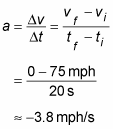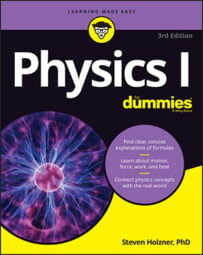In physics calculations, acceleration — just like displacement and velocity — can be positive or negative. The sign of the acceleration tells you whether you’re speeding up or slowing down (depending on which direction you’re traveling).
For example, say that you’re driving at 75 miles per hour, and you see those flashing red lights in the rearview mirror. You pull over, taking 20 seconds to come to a stop. The officer appears by your window and says, “You were going 75 miles per hour in a 30-mile-per-hour zone.” What can you say in reply?
You can calculate your rate of acceleration as you pulled over, which, no doubt, would impress the officer — look at you and your law-abiding tendencies! You whip out your calculator and begin entering your data. Remember that the acceleration is given in terms of the change in velocity divided by the change in time:
Plugging in the numbers, your calculations look like this:

Your acceleration was 3.8 mph/s. But that can’t be right! You may already see the problem here; take a look at the original definition of acceleration:

Your final speed was 0 mph, and your original speed was 75 mph, so plugging in the numbers here gives you this acceleration:

In other words, –3.8 mph/s, not +3.8 mph/s — a big difference in terms of solving physics problems (and in terms of law enforcement). If you accelerated at +3.8 mph/s rather than –3.8 mph/s, you’d end up going 150 mph at the end of 20 seconds, not 0 mph. And that probably wouldn’t make the cop very happy.
Now you have your acceleration. You can turn off your calculator and smile, saying, “Maybe I was going a little fast, officer, but I’m very law abiding. Why, when I heard your siren, I accelerated at –3.8 mph/s just in order to pull over promptly.” The policeman pulls out his calculator and does some quick calculations. “Not bad,” he says, impressed. And you know you’re off the hook.

